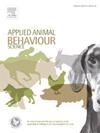Effects of a combination of feed dilution and roughage on home pen behaviour in Ross 308 broiler breeder cockerels
IF 2.2
2区 农林科学
Q1 AGRICULTURE, DAIRY & ANIMAL SCIENCE
引用次数: 0
Abstract
Restricted feeding during the rearing phase is an ongoing welfare challenge in the broiler breeder industry, and there is especially a knowledge gap regarding potential effects of alternative feeding strategies for broiler breeder cockerels. The aim of this study was to investigate the effect of a qualitative feed restriction using diluted feed with insoluble fibres combined with roughage on the home pen behaviour of broiler breeder cockerels. A total of 200 Ross 308 broiler breeder cockerels were housed in 12 pens (6 pens/treatment), 17 birds/pen from 5 to 10 weeks of age. The treatments were standard feed (Control) and feed diluted with 20 % insoluble oat hulls and 150 g of lucerne roughage daily/pen (D+R). The D+R birds received 20 % more feed per day. Observation of home pen behaviours were performed in week 6, 8 and 10 during three different periods of the day relative to feeding time: 1 h prior to feeding, 1 h during feeding and 4 h after feeding. There were no differences between treatments with regards to time spent standing, foraging, locomotion, oral behaviours or aggression. Differences between treatments with regards to drinking and comfort behaviour were found, but the direction of these effects were not consistent across age or time of day. In conclusion, limited effects of diluted feed on home pen behaviour in Ross 308 broiler breeder cockerels were found.
求助全文
约1分钟内获得全文
求助全文
来源期刊

Applied Animal Behaviour Science
农林科学-行为科学
CiteScore
4.40
自引率
21.70%
发文量
191
审稿时长
18.1 weeks
期刊介绍:
This journal publishes relevant information on the behaviour of domesticated and utilized animals.
Topics covered include:
-Behaviour of farm, zoo and laboratory animals in relation to animal management and welfare
-Behaviour of companion animals in relation to behavioural problems, for example, in relation to the training of dogs for different purposes, in relation to behavioural problems
-Studies of the behaviour of wild animals when these studies are relevant from an applied perspective, for example in relation to wildlife management, pest management or nature conservation
-Methodological studies within relevant fields
The principal subjects are farm, companion and laboratory animals, including, of course, poultry. The journal also deals with the following animal subjects:
-Those involved in any farming system, e.g. deer, rabbits and fur-bearing animals
-Those in ANY form of confinement, e.g. zoos, safari parks and other forms of display
-Feral animals, and any animal species which impinge on farming operations, e.g. as causes of loss or damage
-Species used for hunting, recreation etc. may also be considered as acceptable subjects in some instances
-Laboratory animals, if the material relates to their behavioural requirements
 求助内容:
求助内容: 应助结果提醒方式:
应助结果提醒方式:


